
 The mission of Storey Publishing is to serve our customers by publishing practical information that encourages personal independence in harmony with the environment. Edited by Deborah Burns and Aimee Poirier Cover design by Eugenie Delaney Front cover photograph by Cherry Hill, back cover photograph by Richard Klimesh Text design by Cindy McFarland Production assistance by Susan Bernier Line drawings designed by Cherry Hill and drawn by Peggy Judy Copyright 1998 by Cherry Hill Ebook version 1.0 September 17, 2013 All rights reserved. No part of this book may be reproduced without written permission from the publisher, except by a reviewer who may quote brief passages or reproduce illustrations in a review with appropriate credits; nor may any part of this book be reproduced, stored in a retrieval system, or transmitted in any form or by any means electronic, mechanical, photocopying, recording, or other without written permission from the publisher.
The mission of Storey Publishing is to serve our customers by publishing practical information that encourages personal independence in harmony with the environment. Edited by Deborah Burns and Aimee Poirier Cover design by Eugenie Delaney Front cover photograph by Cherry Hill, back cover photograph by Richard Klimesh Text design by Cindy McFarland Production assistance by Susan Bernier Line drawings designed by Cherry Hill and drawn by Peggy Judy Copyright 1998 by Cherry Hill Ebook version 1.0 September 17, 2013 All rights reserved. No part of this book may be reproduced without written permission from the publisher, except by a reviewer who may quote brief passages or reproduce illustrations in a review with appropriate credits; nor may any part of this book be reproduced, stored in a retrieval system, or transmitted in any form or by any means electronic, mechanical, photocopying, recording, or other without written permission from the publisher.
The information in this book is true and complete to the best of our knowledge. All recommendations are made without guarantee on the part of the author or Storey Publishing. The author and publisher disclaim any liability in connection with the use of this information. For additional information please contact Storey Publishing, 210 MASS MoCA Way, North Adams, MA 01247. Storey books are available for special premium and promotional uses and for customized editions.
For further information, please call 1-800-793-9396. Storey Publishing 210 MASS MoCA Way North Adams, MA 01247 www.storey.com Contents Intermediate English Exercises Arena exercises are a cross between gymnastics, meditation, and geometry. They are essential keys for discovering many important principles about training and riding. 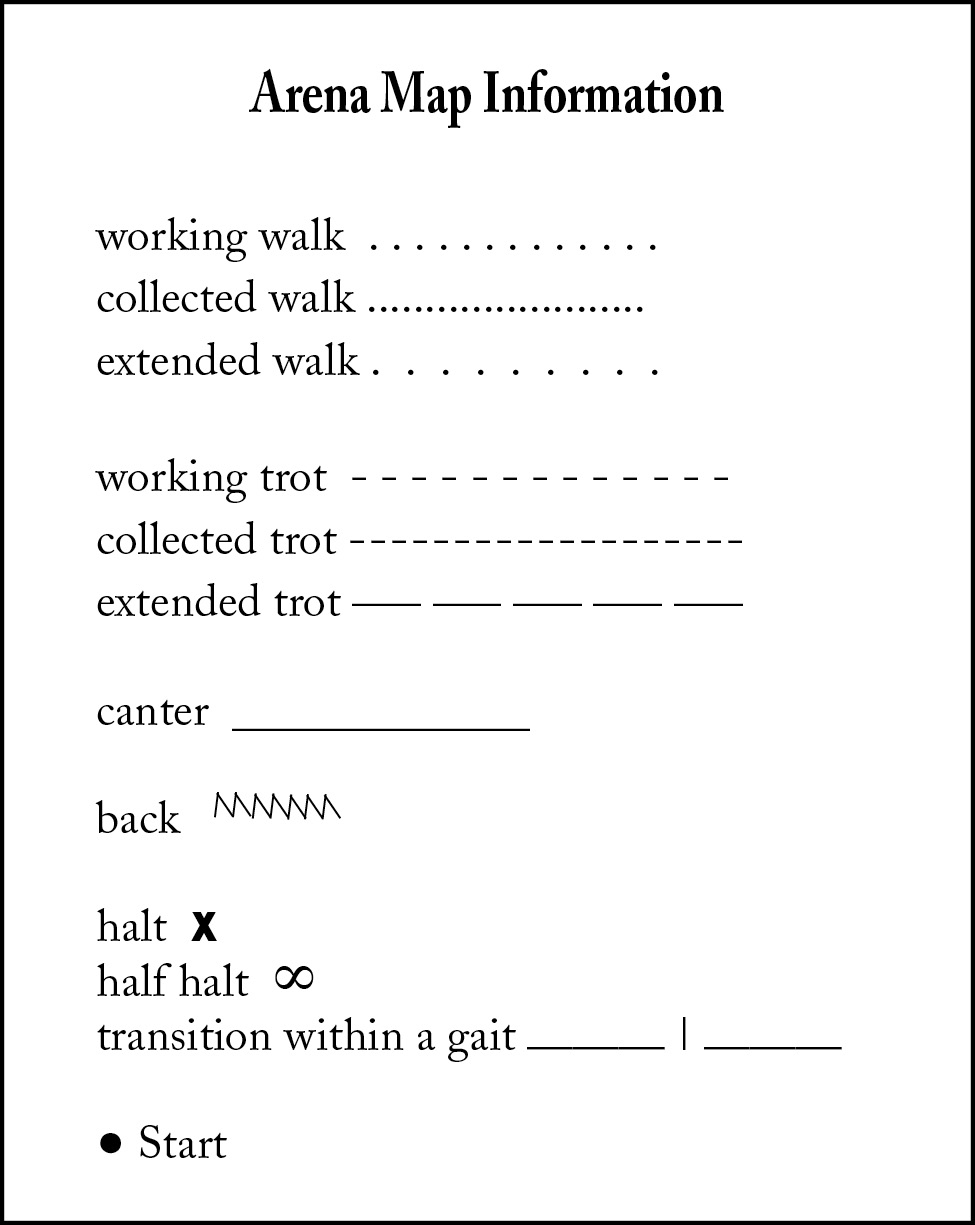 Goals Hone balance and precise use of aids Improve bending Change of rein in a circle Half turns Polish transitions Trot to halt to trot Canter to walk to canter Trot to halt to back to trot Working trot to lengthened trot Develop lateral work Turn on the forehand Leg yield Begin collection The rein back The half halt Remember as you practice that it is the QUALITY of the work that is most important. It is a much greater accomplishment to do simple things well than it is to stumble through advanced maneuvers in poor form and with erratic rhythm. Keep your mind in the middle and a leg on each side.How Can You Tell If the Work Is Correct? Work regularly with a qualified instructor.
Goals Hone balance and precise use of aids Improve bending Change of rein in a circle Half turns Polish transitions Trot to halt to trot Canter to walk to canter Trot to halt to back to trot Working trot to lengthened trot Develop lateral work Turn on the forehand Leg yield Begin collection The rein back The half halt Remember as you practice that it is the QUALITY of the work that is most important. It is a much greater accomplishment to do simple things well than it is to stumble through advanced maneuvers in poor form and with erratic rhythm. Keep your mind in the middle and a leg on each side.How Can You Tell If the Work Is Correct? Work regularly with a qualified instructor.
Ask a qualified person to stand on the ground, observe your exercises, and report to you what he or she sees. Have someone record your exercises on videotape. Then watch the tape carefully using slow motion and freeze frame. As you ride, watch yourself and your horse in large mirrors on the wall. Without moving your head, glance down at your horses shoulders, neck, poll, and eye during different maneuvers to determine if he is correct up front. Ultimately, the key is to develop a feel for when things are going right and when they are going wrong by utilizing all of the above feedback techniques.
Answer the following by feeling, not looking: * Is there appropriate left to right balance on my seat bones? Can I feel them both? * Can I feel even contact on both reins? * Is the front to rear balance acceptable or is the horse heavy on the forehand, croup up, back hollow? * Is the rhythm regular or does the horse speed up, slow down, or break gait? * Is my horse relaxed or is his back tense? * Is he on the bit or above or behind it? * Am I posting on the correct diagonal? * Is my horse cantering on the correct lead? * Can I tell when his inside hind leg is about to land? What Do You Do When Things Go Wrong? Review each component of an exercise. You may need to return to some very basic exercises to establish forward movement, acceptance of contact, or response to sideways driving aids. Returning to simple circle work will often improve straightness and subsequently improve lateral work and collection. Ride an exercise that the horse does very well, such as the walk-trot-walk transition. Work on purity and form. Perform a simpler version of the exercise.
If it is a canter exercise, try it at a walk or trot first. Perform the exercise in the opposite direction. Sometimes, because of an inherent stiffness or crookedness in a horse, you will have difficulty with an exercise to the left but no problems to the right! Capitalize on this by refining your skills and the application of your aids in the good direction and then return to the hard direction with a renewed sense of what needs to be done. I often find that doing work to the right improves work to the left.  EXERCISE 1 Change of Rein in a Circle Posting trot a large circle (66 feet) to the left. At the point of the circle closest to the long side of the arena, turn into the circle and trot a 33-foot half circle to the left.
EXERCISE 1 Change of Rein in a Circle Posting trot a large circle (66 feet) to the left. At the point of the circle closest to the long side of the arena, turn into the circle and trot a 33-foot half circle to the left.
As you finish the half circle, you should be approaching the center of the large circle. Change from left bend to right bend. Change diagonals. Trot a 33-foot half circle to the right. Rejoin the original large circle, now tracking right. You can practice the pattern at a walk, making deeper dips in place of the half circle, giving you a longer diagonal between the two half circles so you have plenty of time to change your bend properly.
You can also practice this exercise at a sitting trot. Be careful not to leg yield as you change bend. Keep a true linear alignment.  EXERCISE 2 Half Halt
EXERCISE 2 Half Halt
| Trot Corner Halt Trot Halt | Trot Half halt Trot Half halt Trot |
A half halt is a preparatory set of aids that simultaneously drives and checks the horse. It is a means of momentarily re-balancing the horse, elevating the forehand, increasing hindquarter engagement, evening an erratic rhythm, slowing a pace, and reminding the horse not to lean on the bit or rush. A half halt is a
momentary holding, immediately followed by a
yielding (within one stride or a split second).
This results in a moment of energized suspension with a listening and light horse. How to Apply a Half Halt Think. Apply seat, leg, and hand aids. Yield. A half halt is an almost simultaneous application of the following with an emphasis on the seat and legs, and a de-emphasis on the hands: * Keep upper body straight or slightly back with elevated sternum. * Keep both lower legs on horses side at the girth. * Use an appropriate intensity with both hands. * Use an appropriate intensity with both hands.
The following is a list in increasing intensity: Close fingers. Squeeze reins. Roll hands inward. Move arm backward from shoulder. Lean upper body back.  The timing of the yield is crucial.
The timing of the yield is crucial.
If you wait so long that you can feel the full effects of the half halt, it is way past time to yield. The yield is what encourages self-carriage. No yield leads to stiffness and tension.
Next page
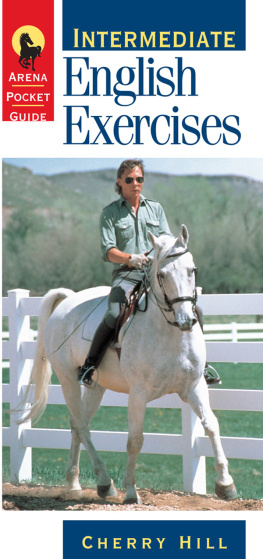

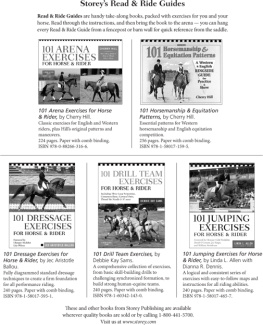
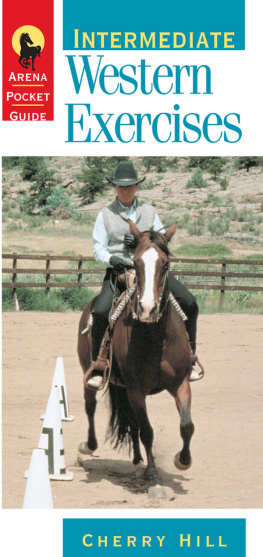


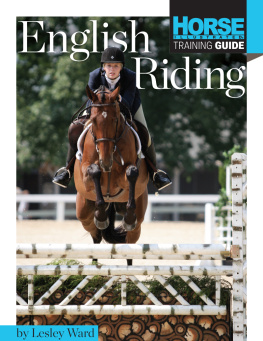

 The mission of Storey Publishing is to serve our customers by publishing practical information that encourages personal independence in harmony with the environment. Edited by Deborah Burns and Aimee Poirier Cover design by Eugenie Delaney Front cover photograph by Cherry Hill, back cover photograph by Richard Klimesh Text design by Cindy McFarland Production assistance by Susan Bernier Line drawings designed by Cherry Hill and drawn by Peggy Judy Copyright 1998 by Cherry Hill Ebook version 1.0 September 17, 2013 All rights reserved. No part of this book may be reproduced without written permission from the publisher, except by a reviewer who may quote brief passages or reproduce illustrations in a review with appropriate credits; nor may any part of this book be reproduced, stored in a retrieval system, or transmitted in any form or by any means electronic, mechanical, photocopying, recording, or other without written permission from the publisher.
The mission of Storey Publishing is to serve our customers by publishing practical information that encourages personal independence in harmony with the environment. Edited by Deborah Burns and Aimee Poirier Cover design by Eugenie Delaney Front cover photograph by Cherry Hill, back cover photograph by Richard Klimesh Text design by Cindy McFarland Production assistance by Susan Bernier Line drawings designed by Cherry Hill and drawn by Peggy Judy Copyright 1998 by Cherry Hill Ebook version 1.0 September 17, 2013 All rights reserved. No part of this book may be reproduced without written permission from the publisher, except by a reviewer who may quote brief passages or reproduce illustrations in a review with appropriate credits; nor may any part of this book be reproduced, stored in a retrieval system, or transmitted in any form or by any means electronic, mechanical, photocopying, recording, or other without written permission from the publisher. Goals Hone balance and precise use of aids Improve bending Change of rein in a circle Half turns Polish transitions Trot to halt to trot Canter to walk to canter Trot to halt to back to trot Working trot to lengthened trot Develop lateral work Turn on the forehand Leg yield Begin collection The rein back The half halt Remember as you practice that it is the QUALITY of the work that is most important. It is a much greater accomplishment to do simple things well than it is to stumble through advanced maneuvers in poor form and with erratic rhythm. Keep your mind in the middle and a leg on each side.How Can You Tell If the Work Is Correct? Work regularly with a qualified instructor.
Goals Hone balance and precise use of aids Improve bending Change of rein in a circle Half turns Polish transitions Trot to halt to trot Canter to walk to canter Trot to halt to back to trot Working trot to lengthened trot Develop lateral work Turn on the forehand Leg yield Begin collection The rein back The half halt Remember as you practice that it is the QUALITY of the work that is most important. It is a much greater accomplishment to do simple things well than it is to stumble through advanced maneuvers in poor form and with erratic rhythm. Keep your mind in the middle and a leg on each side.How Can You Tell If the Work Is Correct? Work regularly with a qualified instructor. EXERCISE 1 Change of Rein in a Circle Posting trot a large circle (66 feet) to the left. At the point of the circle closest to the long side of the arena, turn into the circle and trot a 33-foot half circle to the left.
EXERCISE 1 Change of Rein in a Circle Posting trot a large circle (66 feet) to the left. At the point of the circle closest to the long side of the arena, turn into the circle and trot a 33-foot half circle to the left. EXERCISE 2 Half Halt
EXERCISE 2 Half Halt The timing of the yield is crucial.
The timing of the yield is crucial.